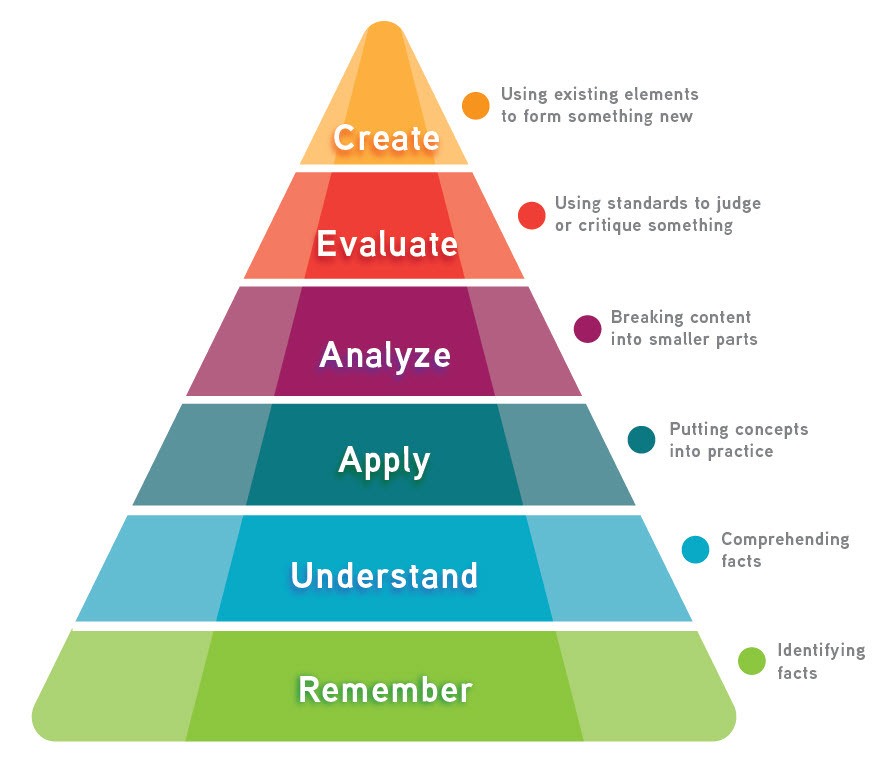Teach with "Higher Order Thinking"
Want to teach the ultimate lesson? Look below for how to do that.
 |
| eLearning Industry |
In my previous posts about teaching developmentally appropriate lessons, I briefly mentioned the need to build from lower levels rather than starting from where we want the students to learn. Using the developmentally appropriate goals and milestones is a great way to monitor that, but Bloom's Taxonomy is also a very important theory to look into.
What is Bloom's Taxonomy?
Here's the definition according to the University of Arkansas. "Bloom’s Taxonomy is a classification of the different objectives and skills that educators set for their students (learning objectives). Bloom’s is hierarchical, meaning that learning at the higher levels is dependent on having attained prerequisite knowledge and skills at lower levels. These 6 levels can be used to structure the learning objectives, lessons, and assessments of your course."
- Remembering: Retrieving, recognizing, and recalling relevant knowledge from long‐term memory.
- Understanding: Constructing meaning from oral, written, and graphic messages through interpreting, exemplifying, classifying, summarizing, inferring, comparing, and explaining.
- Applying: Carrying out or using a procedure for executing, or implementing.
- Analyzing: Breaking material into constituent parts, determining how the parts relate to one another and to an overall structure or purpose through differentiating, organizing, and attributing.
- Evaluating: Making judgments based on criteria and standards through checking and critiquing.
- Creating: Putting elements together to form a coherent or functional whole; reorganizing elements into a new pattern or structure through generating, planning, or producing.
Why should I use this?
Using these verbs is a good way to set up objectives and tasks when you are planning your lesson. It not only keeps you in check, but It also gives your lessons a purpose.
For this age group, you'll mostly stick around the lower levels of the pyramid up to "applying", if you ask me, but as the students' English skills progress, you can move up more.
Let's use this "I Can" statement from the threes post "
- I can talk about myself and other people.
This is a very broad standard, as many standards are, that can cover a few things such as classmates, family, community helpers, etc. Let's use family as "other people."
Next, based on the milestones and "I Can" statements, we know that it's developmentally appropriate for students to:
- connect up to three words in a sentence.
- understand up to three words in a sentence.
- answer yes/no questions.
Our first task will be at the "remember" stage of the pyramid.
- Remembering - identify words for family members. (It's mom, dad, etc)
- Remembering - recall words for family members and answer yes or no questions. (Is this mom? Yes/No.)
- Understanding - describe what you see in the picture using "I see." (Who do you see? I see mom.)
- Applying - draw pictures of people in your family.
Finally, we started from the bottom, now we're here.
- Applying - talk about the people in your drawing.
Using what's developmentally appropriate and the Bloom's model, we were able to create a simple three-year-old lesson plan of maybe three-to-four lessons with structure and purpose. All that's missing are activities, but that's going to be covered in another post.
Stay tuned for the next post. In the meantime, comment with your sample lesson using the DAP (developmentally appropriate practices) and Bloom's taxonomy.
If you're interested in Bloom's verbs for kindergarten, I found "Higher Order Thinking" posters by Blooming Kiddos. I think the power bar idea is so cool to help motivate the students to learn by encouraging them to "boost their power." I think this would be great to hang on the wall of the four to five-year-old classes.

Comments
Post a Comment